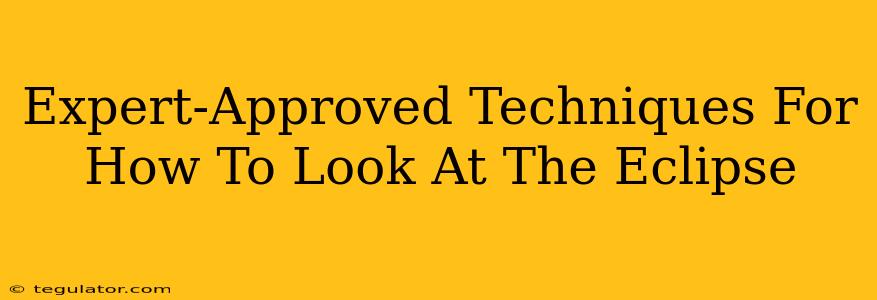Witnessing a solar eclipse is a breathtaking experience, a celestial event that leaves a lasting impression. But looking directly at the sun during an eclipse, even partially, can cause serious and permanent eye damage. This is why understanding how to look at the eclipse safely is paramount. This article outlines expert-approved techniques to ensure you enjoy this spectacular event without compromising your eyesight.
Why You Need Eye Protection During a Solar Eclipse
The sun's rays are incredibly powerful, even during an eclipse. The intensity of its ultraviolet (UV) and infrared (IR) radiation can cause solar retinopathy, a condition that can lead to blurry vision, blind spots, and even permanent vision loss. Never look directly at the sun without proper eye protection, even if the sun appears partially obscured.
The Dangers of Direct Sunlight
The brightness of the sun overwhelms the eye's natural defenses, causing damage to the retina. Unlike other burns, solar retinopathy often has no immediate pain, making it particularly dangerous. You might not realize the damage until hours or even days later.
Safe Ways To View the Eclipse
Thankfully, there are several safe and easy methods to witness this celestial event:
1. Solar Eclipse Glasses (ISO 12312-2 Certified)
This is the most popular and recommended method. Solar eclipse glasses, specifically those meeting the ISO 12312-2 international safety standard, are designed to block harmful UV and IR radiation while allowing you to see the eclipse.
- Check for Certification: Ensure your glasses are clearly labeled with the ISO 12312-2 certification. Avoid glasses that aren't specifically designed for solar viewing.
- Proper Usage: Wear them correctly throughout the entire viewing period. Don't take them off even for a moment while looking at the sun.
2. Indirect Viewing Methods
If you can't access certified eclipse glasses, there are safe indirect methods:
- Pinhole Projector: Create a simple pinhole projector using a cardboard box, aluminum foil, and a pin. This projects an image of the sun onto the inside of the box, allowing you to view the eclipse safely and indirectly. Numerous online tutorials demonstrate how to make one.
- Tree Shadow Projection: The gaps between leaves on trees naturally create a pinhole effect, casting multiple small images of the sun onto the ground. Observe these images instead of looking directly at the sun.
What NOT To Do During an Eclipse
- Don't use regular sunglasses: Regular sunglasses, even very dark ones, are not sufficient to protect your eyes from the sun's harmful rays.
- Don't look directly at the sun without proper eye protection. This is the most crucial point, and the most important advice to remember.
- Don't use homemade filters: Improvised filters made from smoked glass or photographic film are unreliable and extremely dangerous.
Enjoy the Show Safely!
Observing a solar eclipse is a unique and memorable experience. By following these expert-approved techniques and prioritizing your eye safety, you can safely enjoy the wonder and beauty of this celestial event for years to come. Remember: Safety first! Only use certified solar eclipse glasses or proven indirect viewing methods.

